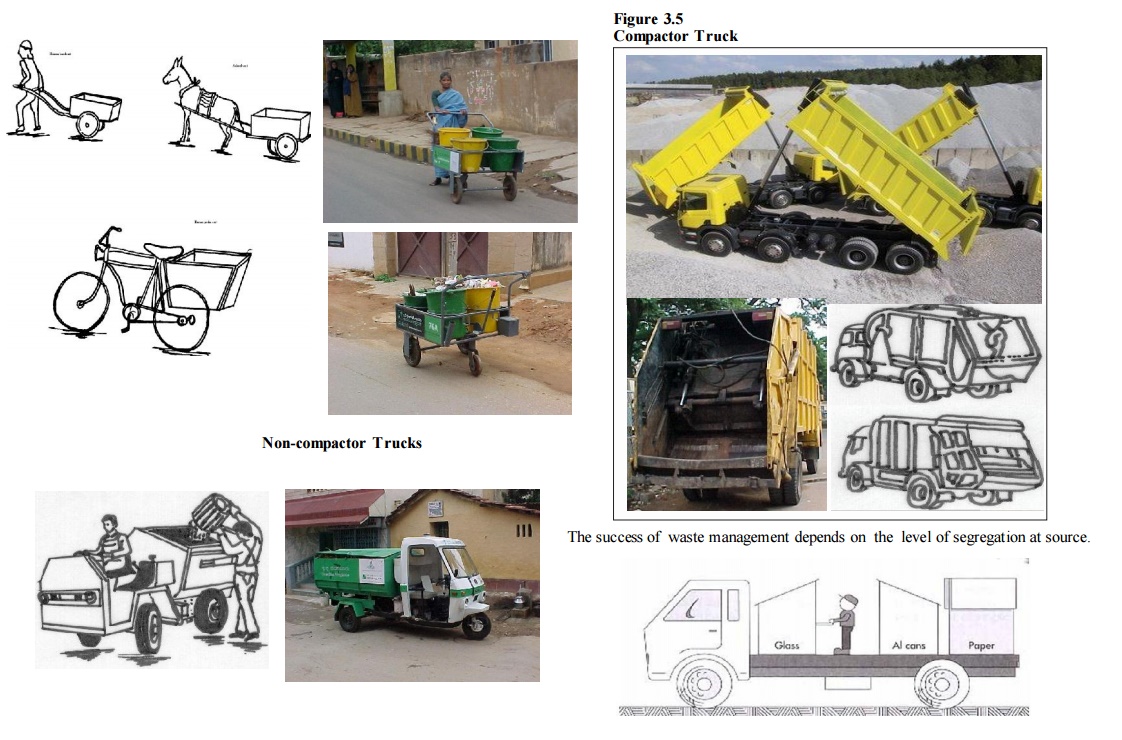Chapter: Civil : Municipal Solid Waste Management : Onsite Storage & Processing
Solid Waste Management: Vehicle storage method

Vehicle
storage method
1
Collection vehicles
Almost all
collections are based on collector and collection
crew, which move through
the collection service area
with a vehicle for collecting
the waste material. The
collection vehicle selected must be appropriate to the terrain, type and
density of waste generation points, the way it travels and type and kind of
material (UNEP, 1996).
It also depends
upon strength, stature
and capability of the
crew that will
work with it.
The collection vehicle may
be small and
simple (e.g., two-wheeled cart pulled by an individual) or large, complex and energy intensive (e.g., rear
loading compactor truck). The
most commonly used collection vehicle is the dump truck fitted with a hydraulic
lifting mechanism. A description of some vehicle types follows:
(i)
Small-scale collection and muscle -powered vehicles: These are common vehicles
used for waste collection in many
countries and are generally used in
rural hilly areas. As
Figure 3.3 illustrates,
these can be small rickshaws, carts or wagons pulled by
people or animals, and are less expensive, easier to build and maintain
compared to other vehicles:
Small-scale
Collection Vehicles: An Illustration

They
are suitable for densely
populated areas with narrow
lanes, and squatter settlements,
where there is relatively low
volume of waste generated. Some
drawbacks of these collection vehicles include limited
travel range of
the vehicles and
weather exposure that affect humans and animals.
(ii) Non-compactor trucks: Non-compactor trucks are
efficient and cost effective in
small cities and
in areas where
wastes tend to be
very dense and have little
potential for compaction.

When these trucks are used for
waste collection, they need a dumping system to easily discharge the waste. It
is generally required to cover the trucks in order to prevent residue flying
off or rain soaking the was tes. Trucks with capacities of 10 - 12 m3
are effective, if the distance between the disposal site and the collection
area is less than 15 km. If the distance is longer, a potential transfer
station closer than 10 km from the collection area is required. Non-compact
trucks are generally used, when labour cost is high. Controlling and operating
cost is a deciding factor, when collection routes are long and relatively
sparsely populated.
2 Compactor truck:
Compaction
vehicles are more common these days, generally having capacities of 12 - 15 m3
due to limitations imposed by narrow roads. Although the capacity of a
compaction vehicle, illustrated in Figure 3.4, is similar to that of a dump
truck, the weight of solid wastes collected per trip is 2 to 2.5 times larger
since the wastes are hydraulically compacted:
Figure 3.5
Compactor
Truck

The
success of waste management depends
on the
level of segregation at source.
A compactor truck allows waste containers to be emptied into
the vehicle from the rear, front or sides
and inhibits vectors
(of disease) from reaching
the waste during collection and transport. It works poorly when waste
stream is very dense, wet, collected materials are gritty or abrasive, or when
the roads are dusty. The advantages of the compactor collection vehicle include
the following:
ü
Containers are unifor m, large, covered and
relatively visually inoffensive;
ü
Waste is set out in containers so that the crew
can pick them up quick ly;
ü Health risk to the collectors and odour on the streets are minimized, waste is relatively inaccessible to the waste pickers.
Related Topics